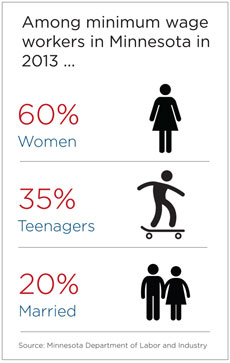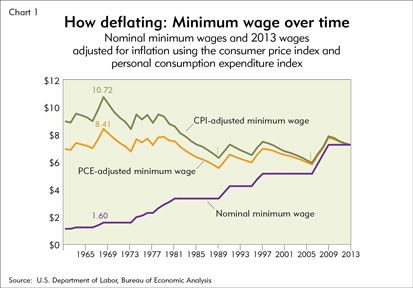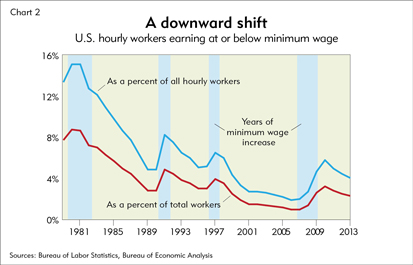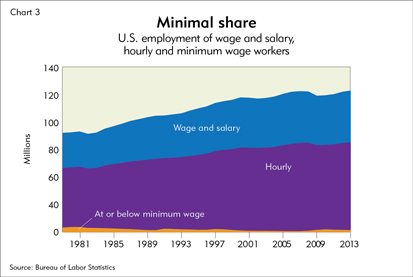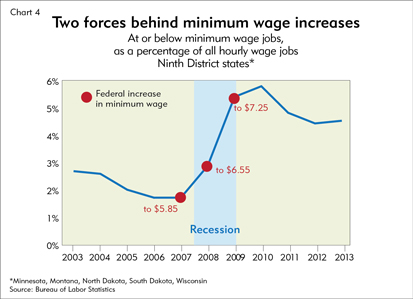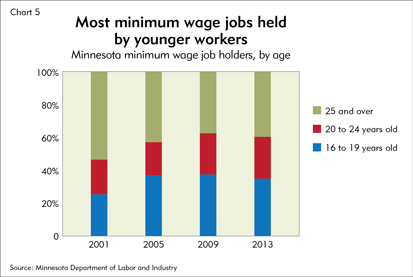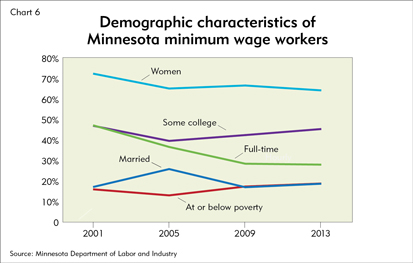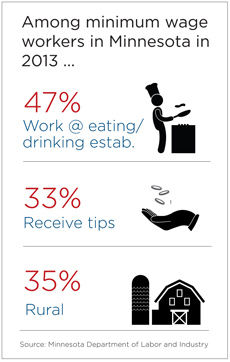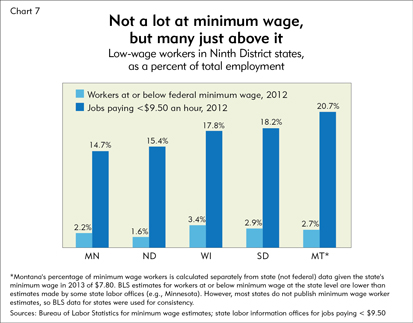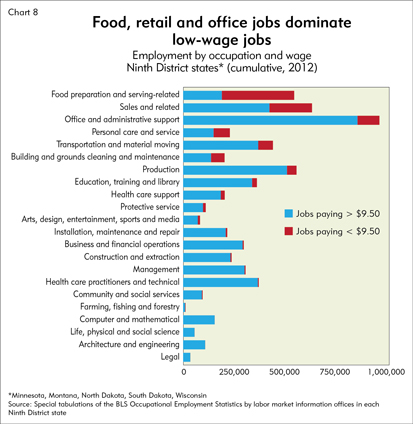Video: fedgazette editor Ron Wirtz on minimum wage
Minimum wage has become a hot-button policy debate this year, the result of numerous factors, including increased attention over income inequality, slow job growth since the recession and inflation’s erosion of the minimum wage’s purchasing power over time.
The issue gained greater salience at the federal level when President Barack Obama proposed a $10.10 minimum wage in his State of the Union speech in January. While that debate goes on at the nation’s Capitol, many states have leapt into the fray, either passing or at least considering a higher minimum wage that supersedes the current federal minimum. In the Ninth District, Minnesota passed a new minimum wage of $9.50 an hour this spring and included provisions for annual cost-of-living increases.
Much of the debate over minimum wages has focused on whether and to what extent higher minimum wages will affect current workers, their employers and overall employment. It’s turned into a polemical fight with many employers arguing that a minimum wage increase would cost jobs and others, such as labor groups, countering that it would help create jobs rather than kill them.
What’s not often discussed is the nature of minimum-wage labor—who has jobs at the bottom of the pay scale and how their participation in the workforce has evolved over time in response to economic growth (and decline) and changes in the minimum wage.
In this broader context, the evolution of minimum wage work and pay has seen both considerable and very little change. For example, the number of workers earning minimum wage spiked during and immediately after the Great Recession, but has been falling of late. From a historical standpoint, since 1980, the number of minimum wage workers has stair-stepped its way lower, rising during recessions and when the minimum wage has been raised. But the long-term trend has been downward.
The purchasing power of the minimum wage also receives a lot of attention. Over the past half-century, there have been some minor differences in the broad trend over time depending on the measure of inflation that is employed. The demographics of minimum wage workers have also shifted in some cases, but hardly at all in others. The types of jobs they hold remain largely unchanged.
There are widespread efforts at the federal and state level to significantly raise minimum wages upward of $10 an hour. If these efforts are successful, the fraction of workers affected by such an increase would exceed the fraction of minimum wage workers of the early 1980s—when the share was much higher—in large part because this new, higher minimum wage would be notably above the inflation-adjusted minimum wage paid to workers back then.
Minimum wage, $1.01
The minimum wage has a relatively long history in the United States, first put in place by Congress in 1938 at 25 cents an hour. It has been raised a total of 22 times since then; many of those were incremental increases as part of a single, larger increase implemented in phases. For example, the most recent federal increase in the minimum wage—from $5.15 to $7.25, approved in 2007—was implemented in annual increments starting at $5.85, to $6.55 a year later and finally to $7.25 in 2009.
Some states set their own, different minimum wage. A total of 21 states (including Michigan, Minnesota and Montana) and the District of Columbia have minimum wages above the federal minimum wage, according to the U.S. Department of Labor. In May, Michigan raised its minimum wage to $9.25 an hour. Montana’s minimum was raised this year to $7.90 thanks to an automatic cost-of-living adjustment, a trigger which only a handful of states have.
A lot of attention gets paid to the long-term, negative effects that inflation has on the purchasing power of the minimum wage. This wage erosion is a central reason for periodic increases. But whether raises have been large and frequent enough to retain the purchasing power of the minimum wage depends on which measure of inflation is used to adjust wages.
Most analyses use the common consumer price index, which shows the value of the minimum wage peaking above $10 an hour in the late 1960s (when it was $1.60 in nominal terms, see Chart 1). But the CPI is widely believed to overstate inflation, and many economists use the personal consumption expenditures (PCE) deflator to adjust wages over time.
Such a matter might seem trivial, but it becomes more important in the long term. When wages are adjusted using the PCE, the oft-cited, higher minimum wages of the 1960s and 1970s become less so. Over the past half century, PCE-adjusted minimum wages have remained fairly constant, dropping from the 1960s through 1989, but rising since then.
Even PCE-adjusted wages, however, show that minimum wage workers haven’t been making any progress in terms of earnings. But when government hasn’t adjusted minimum wages upward, the job market has taken the matter into its own hands, with workers either leaving minimum wage jobs for higher-paying ones or employers increasing wages above the minimum, evident in the long-term decline of total workers receiving minimum or below-minimum wages (see Charts 2 and 3).
In 1980, there were 7.7 million workers earning the minimum wage of $3.10 ($7.56 in 2013 PCE-adjusted dollars). That represented 15 percent of all hourly workers and more than 8 percent of total employment. Since then, the number of workers earning minimum wage has fallen, and the share of total employment consisting of minimum wage workers has fallen over time as well.
Their numbers pulse up on occasion, which typically comes from a recession, an increase in the minimum wage or both. That was particularly the case during the last recession. Coupled with minimum wage increases from 2007 to 2009, the national share of minimum wage hourly workers more than doubled to 6 percent, or about 4.4 million.
The same general arc was traced in the Ninth District (with some variations and caveats; for example, state-level figures before 2001 were unavailable). The share of minimum wage workers across five district states slid as low as 1.6 percent in 2006 (about 65,000 workers), but would later spike to almost 6 percent by 2010, to more than 225,000 workers (see Chart 4). (Methodological issues also suggest that these state-level figures might underestimate actual levels. See sidebar for discussion.)
Even North Dakota—with very strong economic and job growth—saw largely the same trend in minimum wage workers as other district states during and after the recession. At 1.6 percent in 2013, it has the lowest proportion of minimum wage jobs as a percentage of hourly employment in the district (Minnesota is second at 2.3 percent). But in 2009, North Dakota had reached 6 percent.
What’s changed?
Reasonably good data on minimum wage jobs and workers exist in single-year snapshots. For example, in 2013, women were more likely than men to have minimum wage jobs; a majority of minimum wage workers are under the age of 25 and have not been to college. Most are single and hold a part-time job.
Minnesota is one of few states that offer any comprehensive data on minimum wage workers over time. These data suggest that some characteristics of minimum wage workers and jobs are changing, but others not at all.
For example, in 2001, the majority of minimum wage jobs (53 percent) in Minnesota were held by those 25 years or older, but that had fallen to about 40 percent by 2013, according to figures from the state Department of Labor and Industry (see Chart 5). This trend in higher percentages of young people holding minimum wage jobs runs counter to their share of total employment, which has been dropping.
Other demographic changes in Minnesota were more subtle. The percentage of women with minimum wage jobs has fallen from 67 percent to 60 percent over this period, perhaps the result of increased education levels among women. Several commonly referenced traits of minimum wage workers (marriage, poverty, college participation) have held mostly steady in Minnesota (see Chart 6). But one notable outlier is the share of minimum wage workers at full-time jobs, which fell by more than one-third, from 45 percent in 2001 to 28 percent this past year.
Rising tide for higher minimum
While Congress debates a higher federal minimum wage, many states and even cities are leapfrogging the matter by passing laws of their own to boost minimum wages.
Since last fall, California, Connecticut, Hawaii and Maryland have all passed minimum wage hikes to $10 or $10.10 an hour, though all will take at least two years to be phased in; the earliest will be in California, at $10 an hour beginning in January 2016. The District of Columbia is doing that one better by going to $11.50 an hour in July 2016.
Minnesota’s increase to $9.50 an hour will be phased in with three annual bumps (the first, to $8 an hour, is slated for August) and fully implemented by July 2016. Starting in 2018, the state will also adjust the minimum wage on an annual basis using the implicit price deflator to gauge the rate of inflation. The inflationary increase is capped at 2.5 percent per year.
Many states, even those with minimums higher than the federal level, are not standing pat. The National Conference of State Legislatures reports that 34 states have considered or are currently considering increases to the state minimum wage. The National Employment Law Project estimates that 120 cities nationwide have enacted rules requiring higher wages for businesses, though many target only businesses that receive public contracts.
In South Dakota, a measure to increase the state’s minimum wage is on the November 2014 ballot as an initiated state statute. If passed by the electorate, the measure would automatically increase the minimum wage from $7.25 per hour to $8.50 beginning Jan. 1, 2015, and would include an annual cost-of-living adjustment. The measure also would set the wage of tipped workers at half that of the minimum wage, raising that hourly pay from $2.13 to $4.25.
These widespread efforts have given rise to more research on the effect of higher minimums on workforce earnings. For example, a report earlier this year by the Congressional Budget Office found that a $10.10 minimum would push up earnings for more than 16 million workers—about 12 percent of all job holders. A December study by the Economic Policy Institute came to a similar conclusion. (Studies like the CBO’s also discuss potential negative effects on total employment; the CBO, for example, estimates that a $10.10 minimum would lower total employment by a half million workers. A full analysis of these employment trade-offs is outside the scope of this article.)
The more, the merrier?
Other state-level data suggest similar earnings effects on low-wage workers. A December study by the Minnesota Department of Employment and Economic Development investigated the number of jobs paying less than $9.50 an hour using the federal Occupational Employment Survey (OES), which is administered by state labor agencies. It found 388,000 such jobs in Minnesota in the first quarter 2013, or 14.7 percent of total employment. It also found considerable regional variation, from a low of 12.5 percent of total employment in the Twin Cities metro to almost 20 percent in northeast and southwest regions of the state.
At the request of the fedgazette, state labor information offices in other district states provided similar state-level OES data on jobs paying less than $9.50. Across the district in 2012, the share of these jobs as a percentage of total employment ranged from Minnesota’s low of 14.7 percent to a high of 20.7 percent in Montana (see Chart 7). It shows that while there are comparatively few workers at minimum wage or less, there is a considerable population just above that wage.
In Montana, for example, a little less than 3 percent of all workers earn the minimum wage there ($7.80 an hour in 2013). But almost 21 percent earn less than $9.50 an hour, and the proportion grows to almost one-third of workers paid by the hour. This is likely due, in part, to the state having a higher proportion of small businesses. Almost one of five jobs in Montana is with a company having fewer than 10 employees—double the rate in Minnesota—and small companies typically pay less than larger ones.
Jobs paying minimum wage or less tend to be concentrated in occupations such as food preparation and serving, retail, office administration and personal care. Those concentrations also hold for jobs earning less than $9.50, according to OES data from district states (see Chart 8).
Should all district states hypothetically mirror Minnesota in upping their minimum wage to $9.50, roughly 1 million jobs would be affected (all other things equal). That’s about 16 percent of total employment in district states, and almost double the fraction of jobs that were minimum wage jobs in the national economy in 1980. While a notable increase, it’s largely the result of a minimum wage—at $9.50—that would be substantially higher than the comparable PCE-adjusted wage in 1980, which was about $7.50 an hour.
Related content
The art of tracking low-wage jobs and workers
Not all minimum wage jobs are created equal
More On
Ron Wirtz is a Minneapolis Fed regional outreach director. Ron tracks current business conditions, with a focus on employment and wages, construction, real estate, consumer spending, and tourism. In this role, he networks with businesses in the Bank’s six-state region and gives frequent speeches on economic conditions. Follow him on Twitter @RonWirtz.



